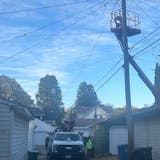Minnesota's weather whiplash, from seemingly endless snow to shorts, has marked the coming of flood season. And local and state leaders are on edge.
As cities fill sandbags and close roads, weather and emergency management experts gathered Thursday to warn Minnesotans of what's to come. Meanwhile, legislators bolstered the state's disaster fund to ensure relief dollars are ready.
"We are going into the heart of our flood season," said Twin Cities National Weather Service meteorologist-in-charge Dan Hawblitzel. "With this rapid warm-up, this rapid three-day-long summer we've got, that snow is rapidly melting and that snow has got to go somewhere. And it's going right into the rivers around the state."
Places along the Mississippi, Minnesota and St. Croix rivers are poised to reach flood levels in the next few days and crest late next week, according to a National Weather Service projection. It showed the Red River facing moderate flooding over the next couple of weeks.
Hawblitzel, along with Gov. Tim Walz and others who will help Minnesota navigate the flood season, held a news conference to highlight areas of concern in the state and their plans to respond. They warned Minnesotans to stay away from rivers, avoid driving through floodwater and get flood insurance if needed.
Minnesota has the lowest percentage of households with flood insurance of any state, said Department of Natural Resources flood plain manager Ceil Strauss. In part, that's because fewer people in Minnesota live in flood plains compared to other states, she said, but the number of people covered here has dropped in recent years as premium costs climbed.
"As we're seeing bigger and bigger storms and floods in more areas, we'd like people be more aware of their risk. Because we should have more people with flood insurance," Strauss said.
As experts forecast flood locations and warned individuals to be cautious, the state Senate was voting on $40 million to replenish the state's nearly-empty disaster assistance contingency account.


